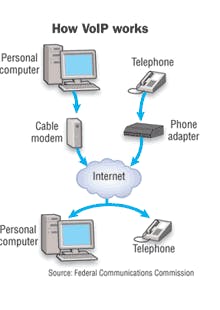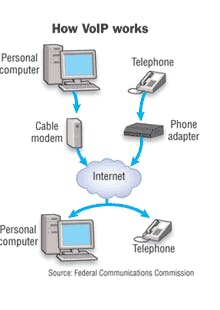Voice over Internet Protocol (VoIP) is making inroads, albeit slowly. But it won’t likely have a huge impact on cabling networks, or require the installation of new cabling infrastructure.
Through VoIP, voice information is sent in digital form in discrete packets rather than in the traditional circuit-committed protocols of the public switched telephone network (PSTN). A major advantage of VoIP and Internet telephony is that it avoids the tolls charged by ordinary telephone service.
Manufacturers met recently at the VON Fall 2005 Conference & Expo in Boston to assess VoIP’s progress in the market. The message was a mixed one.
“We are accelerating, but it is still early for VoIP,” said Charles Meyers, group vice president of marketing for Level 3 Communications, LCC (www.Level3.com). “We are hitting from behind in the court.”
Meyers said VoIP is not growing as expected. The applications have not advanced beyond the early adopter stage. Today, there is less than 3% VoIP penetration in U.S. households, and only a handful of providers have more than 100,000 subscribers. VoIP revenue amounts to less than a handful of total voice revenues.
Meyers said purchasing interest in VoIP has remained flat, increasing only 2%, from 24% to 26% during the past 10 months. “Interest in VoIP has not grown, and providers have not communicated about its reliability to the masses,” said Meyers. “We have a long ways to go.”
Still, Meyers said there is reason for optimism that VoIP will become more popular in 2006. But if there is reason for optimism, what’s in it for cabling contractors?
Unfortunately, not very much. VoIP is mostly considered a network technology. And true, it still requires cabling infrastructure for it to function. But that technology has largely been installed.
Whereas gigabit and 10-Gbit Ethernet applications have called for the installation of advanced cabling solutions, VoIP won’t drive the installation of new types of cable. At least, not yet.
“The technology is there, so will the compression of voice over data cable drive changes? No,” says Paul Capozzoli, product manager, operations support systems division, Agilent Technologies (www.agilent.com).
VoIP is a way to make and receive calls over the data network. Through VoIP technology, phone calls are transferred into data and sent through high-speed Internet. There are four different methods of communication that VoIP offers: computer to computer, computer to telephone, telephone to computer, and telephone to telephone.
VoIP uses packet switching, which is more efficient since it transmits compressed data called a packet. The packet of data is then sent from one system to another. Packet switching allows several telephone calls to be made to the same space that only one call would inhabit in a circuit switched network.
To use VoIP technology, an end user needs:
• A traditional telephone linked to a VoIP converter or system, or a specialized VoIP-enabled phone or so-called “smart phone.” This contains plugs for the phone and PC.
• A microphone and speakers on the PC and a soft phone application for the PC.
To make VoIP work, control software must be downloaded onto the server in a data center. The software application controls the VoIP calls. A gateway, meanwhile, behaves as a bridging between the local PSTN and IP network for voice and FAX services. Gateways are designed to smoothly transport voice and FAX services between the PSTN and the IP network without any distortion. The gateway is installed at the enterprise or at the central office.
With VoIP technology, the end user can simply place and receive calls as usual. The end user’s voice is converted into small packets of digitized sounds and sent down the line to the receiver. On the other end, the packets are converted back into understandable language.
Some argue that VoIP technology will have a big impact on cabling systems, requiring new cable to be pulled for the demanding applications.
“So, you have a physical plant with a set of network capabilities to make these work,” said Bill Wohnoutka, vice president of market management, Consumer Voice Service, Level 3. “This should lead to growth in data cabling and more need for voice cabling over time.”
But this may be a minority view. While it is true that VoIP’s network technology depends on a cabling infrastructure, VoIP requires only low-bandwidth cabling. Since Ethernet is the IP transport, VoIP requires at least Category 5 cabling in the LAN.
“You do need better cable for voice, but it does not require much bandwidth,” said Michel Nadeau, president of Minacom (www.minacom.com), which makes testing equipment for VoIP.
It is because of this that many agree that while VoIP may have potential, in the long run, it simply won’t mean a lot to those who install cable. Switches and routers in the LAN might have to be upgraded to handle more traffic, but from a cabling point of view, VoIP would be transparent.
In today’s enterprise end user climate, where most have already installed at least Category 5 cabling, new installations will not be in demand for VoIP. Old buildings that do not have at least Category 5 cable will have to be recabled for VoIP. But if they have Category 5, 5e, or 6 cabling, they won’t need new cable pulled in. The introduction of VoIP will only require the end user to install new phones.
“I don’t think VoIP will drive more cable,” said Nadeau. “Video might.”
If there is a place for contractors in the world of VoIP, it most likely will come in the area of signal testing. VoIP requires low bandwidth, but it also requires a high-quality sound.
“Contractors have to make sure they have the right tools to measure the quality on the network, and make sure there is no significant loss,” says Kurt Krueger, director of sales, Indirect Telecom, for Ericsson (www.ericsson.com).

